-
By EV Plug Pros
- 0 Comments
Deciding between Level 2 and DC Fast Chargers for your Golden fleet or commercial property? The right choice depends on your specific needs for charging speed, cost, and usage patterns. We’ll help you navigate the options.
For businesses in Golden considering electrifying their fleet or adding EV charging for customers and employees, a fundamental decision is between Level 2 (AC) chargers and DC Fast Chargers (DCFC). Both offer distinct advantages, and the “best” option isn’t universal—it’s about matching the technology to your operational demands.
The Key Takeaway:
Level 2 chargers are generally ideal for overnight charging, employee/customer amenities, and situations where vehicles are parked for several hours. They offer a balance of cost-effectiveness and sufficient charging speed. DC Fast Chargers are crucial for high-utilization fleets, public charging hubs, or situations requiring rapid turnaround times, despite their higher cost.

Level 2 (AC) Chargers: The Workhorse for Many Businesses
How they work: Level 2 chargers use a 240-volt AC (Alternating Current) power source, similar to what powers large appliances. The vehicle’s onboard converter then changes the AC to DC for the battery.
Charging Speed: Typically add 12 to 80 miles of range per hour, depending on the charger’s power output and the vehicle’s acceptance rate. A full charge can take 4-8 hours.
Pros for Commercial Use:
- Lower Installation Cost: Generally more affordable to purchase and install compared to DCFC.
- Wide Compatibility: Compatible with virtually all EVs.
- Grid-Friendly: Places less immediate strain on the electrical grid, potentially leading to lower demand charges from utilities like Xcel Energy.
- Ideal for Longer Dwells: Perfect for employee parking, overnight fleet charging at depots, multi-unit dwellings, and retail locations where vehicles are parked for several hours.
- Scalability: Easier to deploy a larger number of Level 2 ports for widespread access. Cons for Commercial Use:
- Slower Charging: Not suitable for rapid turnarounds or high-volume public charging where speed is critical.
DC Fast Chargers (DCFC): Power for Rapid Turnarounds
How they work: DC Fast Chargers convert AC power to DC power before it reaches the vehicle, delivering high-voltage DC directly to the vehicle’s battery. This bypasses the onboard converter, allowing for much faster charging.
Charging Speed: Can charge an EV battery from 20% to 80% in as little as 20-60 minutes, depending on the charger’s power and the vehicle’s charging capabilities.
Pros for Commercial Use:
- Extremely Fast Charging: Essential for fleets with high daily mileage, public charging stations along travel corridors (like those near US-6 or I-70 near Golden), and businesses like ride-share hubs or taxi services.
- Maximizes Vehicle Utilization: Minimizes downtime for vehicles, allowing them to get back on the road quickly.
- Higher Throughput: Can serve more vehicles per day.
Cons for Commercial Use:
- Higher Installation Cost: Significantly more expensive to purchase and install due to complex power electronics and higher electrical service requirements.
- Higher Operating Costs: Can incur higher demand charges from utilities due to the large power draw.
- Larger Footprint: Often require more space for installation.
- Vehicle Compatibility: While most newer EVs support DCFC, some older models or PHEVs may not, or may have slower DCFC rates.
Local Context & Analysis for Golden Businesses
When making this decision in Golden, consider:
- Fleet Type & Daily Route: Are your vehicles doing short, frequent runs (favoring DCFC for quick top-offs) or longer routes with overnight depot charging (where Level 2 might suffice)? Golden’s municipal fleet, for instance, is planning for full electrification, and their needs might include a mix of charging speeds based on vehicle type and duty cycle.
- Existing Electrical Infrastructure: Golden’s specific building codes and utility connections will influence the feasibility and cost of major electrical upgrades needed for DCFC. We can assess your current setup and advise on necessary upgrades.
- Parking & Dwell Time: For businesses providing charging for employees or customers, how long do vehicles typically stay on your property? A long dwell time makes Level 2 a more sensible and cost-effective choice.
- Budget & Incentives: While DCFC costs more, remember that Colorado’s Fleet-ZERO program offers higher incentives for these high-powered units (up to $70,000 for 100kW+ units), which can significantly offset the initial investment. Golden’s commitment to EV infrastructure may also lead to local incentives.
EV Plug Pros Expertise
At EV Plug Pros, we leverage our expertise to provide balanced, informed advice. We’ve helped numerous businesses and fleets in Golden make the right charging choices based on their unique operational models and budgets. We can perform a detailed site assessment and propose a tailored solution, even a mix of Level 2 and DCFC, to meet your needs perfectly while navigating Golden’s specific regulations and opportunities.
Still weighing your options for commercial EV charging in Golden? Get a personalized consultation from EV Plug Pros to determine the best Level 2 and DC Fast Charger strategy for your business!

